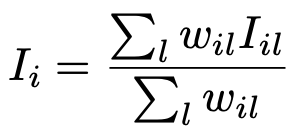How Allora's Collective Intelligence Network Echoes the Principles of Evolutionary Biology

For generations, the emergence of life on Earth has inspired the development of new technologies. The Allora Network is no exception: its design and mechanics draw considerable inspiration from evolutionary biology. As a result, Allora's design has striking similarities to the mathematical equations used to describe natural selection and evolutionary fitness.
These processes in Allora are not only similar in function, but they are also optimized in a way that mirrors evolutionary advantages. Allora incentivizes "survival of the fittest" through context awareness, which leads to continual improvement, much like evolutionary adaptability.

Just as biological populations adapt through the selection of the fittest individuals, Allora adapts through its Inference Synthesis mechanism to improve network-wide inferences over time. This process optimizes the combination of the inferences with context-aware forecasts of their performance to achieve the highest network accuracy. Over time, the resulting inferences are compared to the ground truth, allowing the network to learn which network participants to attach more weight to, similar to how natural selection optimizes population fitness.
The decentralized nature of Allora, where many independent agents contribute to the intelligence of the network, mirrors the importance of genetic diversity in evolutionary biology. Such genetic diversity allows for a robust response to environmental changes, much like how a great variety of worker inferences and forecasts in Allora helps improve the network inferences across different contexts.
Machine Fitness
The concepts of loss (representing the performance of a model) and regret (representing the outperformance of the network compared to individual models) in Allora are used to determine the influence of an individual model in the construction of the network inference. This makes these quantities analogous to evolutionary fitness, i.e. individual reproductive success.
In evolutionary biology, the "Price equation" describes how the frequency of a trait changes over time as a function of its current frequency and its evolutionary fitness. Specifically, it equates the change in frequency to the covariance (or the degree of correlation) between the current frequency and the trait's fractional fitness; in other words, its fitness relative to the fitness of the entire population. A positive covariance means that a trait increases fitness, and thus its frequency will increase. A negative covariance means that a trait decreases fitness, and thus its frequency will decrease.

Allora's Inference Synthesis mechanism relies on workers forecasting each other's losses (see Equation 2 in the Litepaper), which mirrors evaluating the fitness of different strategies or traits in a population. Organisms with higher fitness are more likely to contribute to the next generation. Similarly, in Allora lower forecasted losses lead to greater influence on the network inference.
See equations 3-7 from the Litepaper:

Furthermore, the use of weighted averages in Allora to combine individual inferences into a network inference parallels how genetic contributions are weighted by fitness in biological systems. Higher fitness (or analogously lower forecasted loss or higher regret) leads to a greater contribution to the next generation (or network inference). See Equation 9 from the Litepaper:

A similar parallel exists in how Allora handles the losses reported by reputers. If the contribution of an individual reputer increases the degree of consensus within the network, then the reputer has high "fitness" and it will be listened to. However, if the contribution of a reputer decreases the degree of consensus, then it has low "fitness" and the network will decrease that reputer's say in determining the consensus.
See Equation 29 from the Litepaper:

Context-Aware Self-Improvement
In general, the mathematical formulation of Allora echoes the mathematical models in evolutionary biology that optimize certain parameters (like fitness) over generations. Allora's feedback mechanisms, incentive structure, and iterative improvements mirror the same evolutionary processes that have shaped life on Earth, where each generation seeks to improve its fitness, and carries over these context-dependent adaptations to future generations.
Harnessed within Allora, these evolutionary strategies could enable superior decision-making in highly competitive areas, such as financial markets, autonomous vehicles, or healthcare, where adaptability and learning from diverse data inputs are crucial.
Allora's architecture does not just mirror the evolutionary processes that have optimized biological systems, but also enhances them through advanced computational models and decentralized structures. This fusion of natural evolutionary principles with cutting-edge technology allows Allora to excel through context-awareness, adaptability, and self-improvement, pushing the boundaries of what decentralized systems can achieve. As we continue to explore these biological analogies, Allora's potential applications expand, promising a future where machine intelligence is as dynamic and responsive as the natural systems that inspired it.







